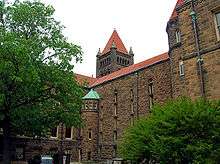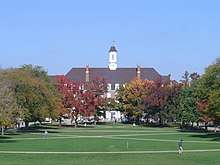University of Illinois system
The University of Illinois System is a system of public universities in Illinois consisting of three universities: Chicago, Springfield, and Urbana–Champaign. Across its three universities, the University of Illinois System enrolls more than 89,270 students.[2] It had an operating budget of $6.97 billion in 2020.[2]
 | |
| Type | Public university system |
|---|---|
| Established | 1867 |
| Endowment | $2.81B (2020) |
| President | Timothy Killeen |
| Students | 89,270 |
| Location | , , United States |
| Campus | 3 universities 37 colleges |
| Colors | Blue[1] |
| Website | www |
 | |
Organization
The University of Illinois System of universities comprises three universities in the U.S. state of Illinois: Urbana–Champaign, Chicago, and Springfield. The university in Urbana–Champaign is known as "Illinois", "U of I", or “UIUC”, whereas the Chicago campus is known as “UIC” and the Springfield campus as "UIS".
The system is governed by a Board of Trustees consisting of thirteen members: the governor of Illinois serves as an ex officio member, nine trustees are appointed by the Illinois Governor, and a student trustee elected by referendum represents each of the system's three universities. One of the three student trustees is designated by the governor to have a vote.
The U of I System is led by the president, an executive vice president, a CFO/vice president of finance, a vice president for economic development and innovation, and the chancellors that lead each of the three universities. System leadership works to develop strategies and solutions to address educational and administrative challenges across the system. Centralized system offices staff support the work of the three universities by providing critical services that are vital to its missions.[3]
Chicago
The largest university in the Chicago area, UIC serves approximately 33,000 students within 16 colleges & schools including Applied Health Sciences, Architecture, Design, and the Arts, Business Administration, Dentistry, Education, Engineering, Graduate, Honors, Liberal Arts & Sciences, Nursing, Pharmacy, Public Health, Social Work, Urban Planning & Public Affairs, Law, and the College of Medicine (largest branch of three branches of the medical school) which is one of the nation's largest medical schools. With annual research expenditures exceeding $341 million, UIC is one of five doctoral research universities in the State of Illinois. Playing a critical role in Illinois healthcare, UIC operates the state's major public medical center and serves as the principal educator of Illinois’ physicians, dentists, pharmacists, nurses and other healthcare professionals. The University of Illinois Hospital & Health Sciences System (a.k.a. "UI Health"), which includes the hospital, clinics, and health science colleges, is a part of UIC.
The modern UIC was formed in 1982 by the consolidation of two U. of I. campuses: the Medical Center campus, which dates back to the 19th century; and the comprehensive Chicago Circle campus, which in 1965 replaced the two-year undergraduate Navy Pier campus designated to educate returning veterans.
Springfield

The newest university in the system is University of Illinois at Springfield. It is located in Springfield, Illinois, the state capital of Illinois. When it opened in 1969, it was named Sangamon State University, and was exclusively an upper-level university, serving only upperclassmen and graduate students. In 1995, Sangamon State joined the University of Illinois System and was renamed as the University of Illinois at Springfield. The University of Illinois System then transitioned the school from an upper division university into a full four-year institution with an undergraduate program.
UIS is the smallest university in the University of Illinois System, with an enrollment of nearly 4,300 students. UIS offers more than 50 degree-granting programs. The academic curriculum of the university emphasizes a strong liberal arts core, an array of professional programs, extensive opportunities in experiential education, and a broad engagement in public affairs issues in its academic and community service pursuits. UIS has the lowest student/teacher ratio of all three universities in the U of I System.
Urbana–Champaign


The Urbana–Champaign campus was founded in 1867 as the Illinois Industrial University. It was one of the 37 public land-grant institutions created shortly after Abraham Lincoln signed the Morrill Act in 1862.[4] The university changed its name to University of Illinois in 1885, and then again to University of Illinois at Urbana–Champaign in 1982. The University of Illinois at Urbana–Champaign is the largest and most prestigious of the three universities. UIUC, or more commonly "ILLINOIS," is home to 17 colleges and instructional units including the College of Agricultural, Consumer, and Environmental Sciences; College of Applied Health Sciences; Gies College of Business; College of Education; The Grainger College of Engineering; College of Fine and Applied Arts; Graduate College; Institute of Labor and Industrial Relations; College of Law; College of Liberal Arts and Sciences; Graduate School of Library and Information Science; College of Media; Carle-Illinois College of Medicine; School of Social Work; and the College of Veterinary Medicine.
It is also home to the National Center for Supercomputing Applications, NCSA, where Marc Andreessen (of Netscape fame) and others helped develop the Mosaic web browser, the first HTML browser capable of rendering images. In addition, in 1987, NCSA created NCSA Telnet, a program which permitted users access to the supercomputer's resources remotely. The petascale Blue Waters to be completed in 2011 is among the world's fastest supercomputers.
UIUC and its alumni are particularly well known for their contributions to engineering, including inventions such as the LED, plasma screen, and integrated circuit. The library is notable both for being the largest public academic library[5] in the country, with over forty departmental libraries, and for possessing over twelve million volumes.[6] Each year, the library circulates about 1.2 million items and answers about 293,000 reference questions. The university is highly ranked in psychology, engineering, law, library and information science, chemistry, computer science, labor and industrial relations, educational psychology, finance, accounting, business administration, communication, and music.[7] Physics professor John Bardeen won the Nobel Physics Prize twice in his lifetime, an honor no other researcher has received. The school's marching band, named the Marching Illini, also enjoys a superb reputation. Until recently, the symbol of the University's athletic teams was a Native American figure, Chief Illiniwek, which had sparked significant controversy. Chief Illiniwek completed his last performance on February 21, 2007 and has since been retired from performing and as the official symbol of the school.
Currently the university boasts the world's most technologically advanced Computer Science building, Siebel Center, as well as many other world-class research laboratories such as Loomis Laboratory of Physics.
Global Campus
In January 2008, the University of Illinois launched the Global Campus, the university's initiative in online education. The Board of Trustees established the Global Campus in March 2007 to further the land-grant mission to expand educational opportunities for the Illinois community and beyond with distance education technologies.[8] The University of Illinois Global Campus primarily served non-traditional and place-bound students, in order that they may gain the academic and career benefits of a University of Illinois education without the barriers of location and scheduled class times.
In May 2009, the Board of Trustees voted to phase out the Global Campus Initiative. The University of Illinois transitioned the programs developed by the Global Campus to academic units at the corresponding universities.
Discovery Partners Institute
In 2017 the University of Illinois initiated the Discovery Partners Institute (DPI), a center for tech workforce development and applied R&D in Chicago. Its primary goals are to prepare individuals for careers in Illinois-based tech companies and to bring academic expertise and tech company know-how together within a dedicated building. The DPI is currently located at 200 S. Wacker Dr., with plans for construction within The 78, in Chicago's south loop.
Foundation
The University of Illinois Foundation is the official fundraising and gift agency of the University of Illinois System. In 2017, the Foundation announced its largest and most ambitious comprehensive fundraising initiative, aiming to raise $3.1 billion over five years to support students, faculty, academic, and research programs and facilities[9]. Previously, the U of I Foundation raised $2.43 billion for students, faculty, research and the campus environment through the “Brilliant Futures” fundraising campaign completed in December 31, 2011.
Alumni Alliance
Inclusive of all graduates, current and former students of the University of Illinois System, the University of Illinois Alumni Alliance has the largest alumni membership in the world with more than 690,000 members internationally. The UIAA has offices at each U of I university in Urbana–Champaign, Springfield and Chicago, as well as the Alumni Career Center in Chicago's Loop, which offers comprehensive career services to all University of Illinois alumni. In addition to hosting events, awards programs, and regional and special-interest alumni groups, the UIAA publishes a variety of communications vehicles to inform and connect alumni with the University and each other. It also coordinates the Illinois Connection legislative advocacy network and the EXPLORERS alumni travel program.
Further reading
- Solberg, Winton U. Reforming Medical Education: The University of Illinois College of Medicine, 1880–1920 (Urbana: University of Illinois Press, 2009) 309 pp. ISBN 978-0-252-03359-9
References
- "Color Palettes - University of Illinois System". www.uillinois.edu. Retrieved August 2, 2018.
- "2020 Pocket Facts".
- "2020 U of I System annual report".
- "Facts 2007: Illinois by the numbers". University of Illinois at Urbana. Archived from the original on August 24, 2007. Retrieved September 29, 2007.
- "University Library at UIUC". University of Illinois at Urbana. Retrieved September 29, 2007.
- 12-millionth Volume Acquired Archived August 11, 2011, at the Wayback Machine. Library.illinois.edu (October 5, 2010). Retrieved on 2013-08-17.
- "University and College Rankings at UIUC". University of Illinois at Urbana. Archived from the original on August 24, 2007. Retrieved September 29, 2007.
- "U of I Board of Trustees Meeting, March 13, 2007" (PDF). Archived from the original (PDF) on February 16, 2008. Retrieved February 1, 2008.
- "UIF fundraising campaign 2017".
